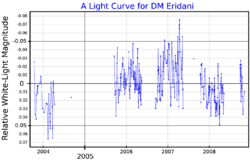Astronomy:54 Eridani
| Observation data Equinox J2000.0]] (ICRS) | |
|---|---|
| Constellation | Eridanus |
| Right ascension | 04h 40m 26.51159s[2] |
| Declination | −19° 40′ 17.3723″[2] |
| Apparent magnitude (V) | 4.32[3] |
| Characteristics | |
| Evolutionary stage | asymptotic giant branch[4] |
| Spectral type | M3/4 III[5] |
| U−B color index | +1.80[6] |
| B−V color index | 1.599±0.021[3] |
| Variable type | SRb[7] |
| Astrometry | |
| Radial velocity (Rv) | −32.9±0.8[3] km/s |
| Proper motion (μ) | RA: +29.13[8] mas/yr Dec.: −96.42[8] mas/yr |
| Parallax (π) | 8.2063 ± 0.2709[2] mas |
| Distance | 400 ± 10 ly (122 ± 4 pc) |
| Absolute magnitude (MV) | −0.93[3] |
| Details | |
| Radius | 69+12 −6[2] R☉ |
| Luminosity | 1,021+33 −38[2] L☉ |
| Temperature | 3,915+190 −293[2] K |
| Other designations | |
| Database references | |
| SIMBAD | data |
54 Eridani is a suspected astrometric binary[10] star system located around 400 light years from the Sun in the equatorial constellation of Eridanus. It is visible to the naked eye as a faint, reddish hued star with a baseline apparent visual magnitude of 4.32.[3] The object is moving closer to the Earth with a heliocentric radial velocity of −33 km/s.[3]
The visible component is an aging red giant star, currently on the asymptotic giant branch,[4] with a stellar classification of M3/4 III.[5] It is a semiregular variable star of subtype SRb, ranging in magnitude from 4.28 down to 4.36.[7] The star has pulsation periods of 18.8 and 45.5 days, each with an amplitude of 0.019 in magnitude.[1] With the hydrogen at its core exhausted, the star has expanded to around 69[2] times the Sun's radius and it is radiating 1,021[2] times the luminosity of the Sun from its swollen photosphere at an effective temperature of 3,915 K.[2]
It was the second-brightest star in the obsolete constellation of Sceptrum Brandenburgicum after 53 Eridani.
References
- ↑ 1.0 1.1 Tabur, V. et al. (December 2009), "Long-term photometry and periods for 261 nearby pulsating M giants", Monthly Notices of the Royal Astronomical Society 400 (4): 1945–1961, doi:10.1111/j.1365-2966.2009.15588.x, Bibcode: 2009MNRAS.400.1945T.
- ↑ 2.0 2.1 2.2 2.3 2.4 2.5 2.6 2.7 2.8 Brown, A. G. A. (August 2018). "Gaia Data Release 2: Summary of the contents and survey properties". Astronomy & Astrophysics 616: A1. doi:10.1051/0004-6361/201833051. Bibcode: 2018A&A...616A...1G. Gaia DR2 record for this source at VizieR.
- ↑ 3.0 3.1 3.2 3.3 3.4 3.5 Anderson, E.; Francis, Ch. (2012), "XHIP: An extended hipparcos compilation", Astronomy Letters 38 (5): 331, doi:10.1134/S1063773712050015, Bibcode: 2012AstL...38..331A.
- ↑ 4.0 4.1 Eggen, Olin J. (July 1992), "Asymptotic giant branch stars near the sun", Astronomical Journal 104 (1): 275–313, doi:10.1086/116239, Bibcode: 1992AJ....104..275E.
- ↑ 5.0 5.1 Houk, Nancy; Smith-Moore, M. (1978), Michigan catalogue of two-dimensional spectral types for the HD stars, 4, Ann Arbor: Dept. of Astronomy, University of Michigan, Bibcode: 1988mcts.book.....H.
- ↑ Mermilliod, J.-C. (1986). "Compilation of Eggen's UBV data, transformed to UBV (unpublished)". Catalogue of Eggen's UBV Data. Bibcode: 1986EgUBV........0M.
- ↑ 7.0 7.1 Samus, N. N. et al. (2017), "General Catalogue of Variable Stars", Astronomy Reports, 5.1 61 (1): 80–88, doi:10.1134/S1063772917010085, Bibcode: 2017ARep...61...80S.
- ↑ 8.0 8.1 Van Leeuwen, F. (2007), "Validation of the new Hipparcos reduction", Astronomy and Astrophysics 474 (2): 653–664, doi:10.1051/0004-6361:20078357, Bibcode: 2007A&A...474..653V.
- ↑ "54 Eri". SIMBAD. Centre de données astronomiques de Strasbourg. http://simbad.u-strasbg.fr/simbad/sim-basic?Ident=54+Eri.
- ↑ Eggleton, P. P.; Tokovinin, A. A. (September 2008), "A catalogue of multiplicity among bright stellar systems", Monthly Notices of the Royal Astronomical Society 389 (2): 869–879, doi:10.1111/j.1365-2966.2008.13596.x, Bibcode: 2008MNRAS.389..869E.
 |


